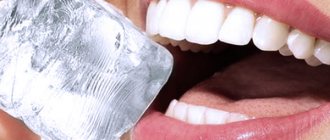A healthy tooth reacts strongly to hot and cold - what does this mean? When hyperesthesia appears, it is important to visit a doctor in a timely manner and undergo a high-quality diagnosis of the oral cavity, since sensitivity is not an independent pathological process, but only accompanies pre-existing systemic disorders in the body.
Treatment does not require the use of radical medical techniques. However, it is better to follow preventive measures and prevent increased susceptibility of incisors, canines and molars to cold and heat.
Why does a reaction to temperature factors occur?
If the chewing front tooth aches and reacts to cold and hot, the reasons may be pathological and non-pathological. Most of them belong to the first type, since within normal limits, dental units should not respond acutely to temperature changes.
Common factors include the following:
- Diseases of the oral cavity. Caries takes 1st place in this group. Very often, people do not think about its presence until they discover unaesthetic dark spots or holes in their mouth. In the initial stages, the disease can only be diagnosed by a dentist, so it is extremely important to regularly visit the clinic for preventive examinations. In the case of pulpitis, everything is much more serious. The destruction reaches the pulp and dentin, and the nerves become inflamed. All this causes severe discomfort, which, in the absence of timely treatment, turns into acute, persistent pain. The tooth reacts to cold, feels when a person drinks hot tea, eats sweet and sour.
- Poorly performed dental intervention. Sometimes after the filling is installed, sensitivity appears. Perhaps the problem lies in poor root canal cleaning and incomplete filling. Hyperesthesia also occurs when the filling material comes into contact with hard tissues. In any case, it is important to see a doctor as soon as possible.
- The patient underwent a professional whitening procedure. The unpleasant symptom remains for several days. However, gradually the enamel layer is restored, and the discomfort disappears. If you carry out the procedure yourself without the involvement of specialists, do it too often and do not follow the recommendations, the teeth will weaken and will respond to temperature and other irritants with pain.
- Malocclusion. The chewing load is distributed unevenly, and the crowns are gradually worn away. Thanks to this, a person acutely feels any temperature changes.
- Violations of the integrity of the enamel. This is possible due to frequent consumption of hard foods, an incorrectly selected toothbrush, or mechanical impact with the formation of chips.
The problem may also be non-pathological. For example, a patient often consumes products containing aggressive acids, sugar, chemical compounds and other components that negatively affect the condition of the oral cavity.
Initial measures to eliminate signs of hyperesthesia
To eliminate unpleasant sensations, the doctor primarily gives the patient the following recommendations:
- exclude predisposing factors;
- do not consume food acids, that is, refuse those products that contain them;
- Carry out hygienic teeth cleaning long before or after meals;
- Reduce the time you spend brushing your mouth to one minute and use a soft-bristle brush.
The patient's teeth are treated with desensitizers. They reduce the sensitivity of teeth of various etiologies by sealing the dentinal tubules. The use of special toothpastes is prescribed.
When the root and neck of a tooth are exposed, mucogingival surgery (vestibuloplasty, etc.) is used to correct gum recession. During surgery, the soft structures of the oral cavity are moved to those areas that require restoration.
For pulpitis, the doctor resorts to pulpotomy. During a dental operation, the pulp is partially amputated using a vital method. At the same time, that part of it that is located in the root canal remains viable.
If sensitivity to irritants persists, additional diagnostics are carried out to exclude chronic pain syndrome, and a more effective treatment plan is drawn up.
Systemic disorders leading to hyperesthesia
Usually, its first signs appear during daily brushing of teeth. Some time after the hygienic procedure, the symptoms disappear, but this does not mean that the pathological process has receded.
If sharp pain occurs during temperature changes, it does not always indicate dental problems:
- Gastritis. The acids released from the gastrointestinal tract are caustic and negatively affect both hard and soft tissues.
- Endocrinological disorders, this also includes diabetes. There is a deficiency of vital vitamins and minerals in the body.
- Age characteristics.
- Hormone imbalance. This occurs when taking certain medications or while pregnant.
- Stressful situations, nervous shock, depression.
- Decreased immunity and accompanying inflammatory and infectious processes.
When pain is normal
There are very frequent cases when the procedure for treating caries and pulpitis is carried out according to all the rules, but pain still occurs.
In this case, the cause of the pain is hyperesthesia.
Excessive sensitivity of dental tissues to various irritants is hyperesthesia.
Symptoms intensify if there are small cracks in the enamel of the teeth. Various factors contribute to the appearance of such cracks:
- Damage to the enamel from mechanical impact (hard bristles of a toothbrush, during the whitening process, due to impact or scratch with cutlery, etc.).
- Exposure of enamel tissue to aggressive nutrients (for example, citric acid).
The effect of dental procedures on the sensitivity of teeth to cold and hot
Often an unpleasant symptom appears after visiting the dentist's office. In most cases, this is possible with the following manipulations:
- Professional whitening. As a result, the enamel becomes very thin. If you do it yourself at home or hire an inexperienced technician, or overuse teeth whitening, hyperesthesia will inevitably appear over time. The same applies to the use of whitening pastes, especially those containing abrasive particles.
- Installation of a seal. Incisors, canines and molars become sensitive immediately after treatment. This is a normal phenomenon that goes away in 1-2 days. There should be no acute pain, so the patient does not experience severe discomfort. If pain increases and other suspicious symptoms are present for 3 days or more, an inflammatory process may have begun, requiring urgent medical intervention.
- Prosthetics. When installing implants and prostheses, hard tissue can be damaged.
Pain after dental treatment
Sometimes the start for the development of hyperesthesia is a visit to the dentist. The doctors themselves admit: the insufficient level of professionalism is entirely to blame for the development of this situation. Teeth may hurt after:
- hygienic cleaning and polishing;
- whitening procedures;
- installation of a photopolymer filling;
- tooth extension, or rather, due to etching of tissues with acid-containing gels.
In the vast majority of cases, an experienced dentist would be able to avoid the development of hyperesthesia. For example, a whitening service in modern clinics necessarily includes a preventive procedure for protecting the enamel. And the development of tooth sensitivity after filling indicates a gross mistake by the doctor. Possibly during treatment:
- not all inflamed tissue was removed by the dentist;
- a burn of the pulp occurred, and as a result, inflammation developed;
- an air bubble remains in the treated cavity;
- the doctor damaged the integrity of the seal;
- individual intolerance to the composite material made itself felt.
Unfortunately, the pain will not subside over time, but will only intensify. Therefore, if the sensitivity of tooth enamel remains unchanged for 7-10 days, it is better to schedule an examination with the dentist again. If the pain increases, you cannot postpone the visit: you need to see a doctor as soon as possible.
Why did a dead tooth begin to react to cold and hot?
Increased sensitivity occurs when nerve endings are irritated. This does not happen after extraction and depulpation. However, it often happens that a unit that is no longer alive hums, whines and causes other discomfort to a person:
- The reaction comes from healthy rows, it just seems to the patient that it is the pulpless one that is hurting. In this case, it is worth visiting a dentist to find out why this is happening. Perhaps the provoking factor was pulpitis, hidden caries or another disease.
- Poor quality treatment. It happens that even the most experienced doctor cannot cope with dental pathology the first time due to the non-standard structure of the root canals. The nerve is partially removed, some elements remain inside and cause pain. It is recommended to take an x-ray and, if necessary, treat the tooth.
- Poor quality of filling. If the filling material is applied incorrectly, inflammation occurs and acute reactions to external irritants are observed.
- Hormonal disorders, infectious diseases. These reasons are not so common, but sometimes they still occur.
Qualified help
Professional help for hypersensitivity involves two highly effective procedures - fluoridation and remineralization. These are safe techniques that can quickly increase the strength of enamel and make it more resistant to the irritating effects of external factors.
Remineralization normalizes the structure of the upper dental layer by saturating it with phosphate , fluorides and calcium. After the session, the unit almost immediately stops reacting acutely to temperature changes.
Fluoridation consists of the use of a fluorine-containing drug. It can be repeated at intervals of several months. The procedure is especially relevant for people living in areas with a lack of phosphorus in tap water.
After treatment and preventive measures, the doctor may prescribe a special remineralizing gel to the patient. It must be used within a month. This should be followed by a long break.
How pain occurs
When teeth cramp and ache from cold and hot, the reaction to external stimuli can be painful. If the problem is not resolved in a timely manner, the pain syndrome will only increase, causing suffering to the patient.
The enamel gradually becomes thinner. The thinner it is, the more painful a person is from external influences. With severe destruction of hard tissues, the nerves are affected, it becomes unpleasant to eat and drink. Even a breath of wind can cause discomfort.
Non-systemic reasons
- Exposure to food acids. They are rich in citrus fruits, cabbage of various varieties, radishes, sweet carbonated waters;
- Non-carious lesions of hard dental tissues. Enamel wears off quickly, especially if not properly cared for;
- Development of caries. It provokes erosion of dental tissues or wedge-shaped effects (V-shaped flaw);
- Mechanical tooth destruction. Occurs during strong impacts, bleaching, grinding for subsequent installation of crowns;
- Inflammation of soft dental tissues (pulpitis). The reason is the penetration of infections, mainly bacterial.
Stages of pathology development
Symptoms are increasing every day. The less attention is paid to the prevention and care of dental units, the faster the problem will turn into incessant excruciating pain. If the tooth and gums begin to react to cold and hot, the process will develop gradually and go through the following stages:
- slight passing discomfort when eating food and drinks with very low or high temperatures;
- then there is an acute reaction to sweet, sour, too salty;
- any external irritants cause unbearable pain, even a breath of wind can provoke pain.
If you notice symptoms, you should see a dentist as soon as possible. Timely therapy guarantees a quick recovery. Otherwise, complications cannot be avoided that are difficult to treat.
Symptoms
The main symptom of tooth enamel hyperesthesia is acute short-term pain. Usually the patient complains that the tooth feels cold, sweet, hot, sour, and begins to hurt. In this case, the pain is short-lived; literally after a few seconds the pain subsides and the tooth stops hurting. The intensity of toothache can range from mild discomfort to very severe throbbing pain. In some particularly difficult cases, patients cannot even breathe in cold air and only take warm, neutral-tasting food.
Typically, pain during hyperesthesia is a constant symptom, but sometimes temporary periods of remission are observed when the teeth do not respond to stimuli at all or the intensity of pain is significantly reduced.
How is diagnostics carried out?
First of all, the oral cavity should be carefully examined by a doctor. By applying a blast of cold air or water, the dentist can test how sensitive the unit is. Then the doctor decides on the advisability of conducting diagnostic procedures. You may need an x-ray, panoramic or spot. In some cases, it is necessary to involve narrow specialists.
Solution
If after the filling procedure pain is diagnosed, then you need to wait 2-3 days, perhaps they will pass.
During this period, it is recommended to take painkillers with anti-inflammatory properties.
The pain does not subside after 72 hours - you should contact your dentist.
At a repeated appointment, the dentist performs the following series of actions for caries:
- Produces local anesthesia.
- Removing the seal.
- Removal of the area affected by caries.
- Reinstallation of the filling.
The stages of treatment of pulpitis (primary or repeated) are as follows:
- Administration of an anesthetic drug.
- Removing the filling and providing access to the tooth canals.
- Treatment of canal-containing areas using dental instruments with parallel exposure to an antiseptic.
- Installing a filling on a dental canal.
- Filling a tooth with a permanent or temporary filling (this is decided by the dentist).
If a doctor has installed a temporary filling for you, this means one thing - you will definitely have to visit him on the appointed day. If this is not done, the consequences may be negative.
Professional treatment
Hyperesthesia is a reason for medical intervention. You should not try to cope with the problem yourself, otherwise complications will not be avoided. High-quality therapy should first of all be aimed at eliminating provoking factors.
What to do if your tooth hurts and reacts to cold and hot water, food, air:
- It is necessary to go through remineralization and fluoridation. The enamel layer is additionally fed with fluoride and calcium. A special composition with a high concentration of these components is applied to the surface. The procedures are carried out for preventive purposes to prevent caries.
- Iontophoresis involves the introduction of a special drug into hard tissues using galvanic current.
- Installation of prostheses, implantation. If the rows are very damaged, they can only be restored in this way. The doctor determines which method is optimal in a particular case: restoration with veneers, the use of composites, artificial crowns.
What to do if your teeth are afraid of cold and hot, first of all? Dentists adhere to a clear algorithm:
- initial examination and diagnosis of possible dental diseases, inflammations;
- development of a plan for further action;
- sanitation of the oral cavity and elimination of pathological foci;
- elimination of plaque and stone;
- treatment with remineralizing compounds.
Hypersensitivity after tooth filling and preparation for dentures
Most often in dental practice, increased sensitivity is observed after filling. Patients come to the clinic with complaints of sensitivity, especially to cold, without precise localization of pain. Upon visual examination, sensitivity in the basal part is not detected. There is no evidence of open pulp or caries on the x-ray.
The causal unit, however, can be identified. To do this, use ice, which, wrapped in a paper napkin, is applied to the cheek area or to the surface of the tongue. An area with a violation of integrity in hard tissues is a source of irritation, so severe pain occurs in the tooth. Removing all filling material will allow you to detect the break.
The reason for increased susceptibility, often to cold or too hot food, may be the appearance of microgaps between the filling and the hard tissues of the tooth due to compression of the composite material. The gap formed in the cavity near the root canals opens up space for the movement of dentinal fluid, thereby causing a response from the nerve endings of the pulp.
The area of contact of the material with the walls of the internal space of the tooth can also contribute to the formation of hypersensitivity after filling. Since filling composites have a high elasticity index, they cause stress in the contact layer “filling - hard dental tissue”. The tension in the tooth tissues is greater in cases where the surface of the restoration in contact with the walls is extensive.
After preparation (grinding) of a tooth for prosthetic structures and microprostheses, normal sensitivity is observed, which is characterized by mild pain. If there is no inflammatory process in the pulp, the pain is considered causative and disappears a few minutes after the drill stops working. If hypersensitivity persists for a long time (2 or more days after the procedure), treatment of pulpitis is required.
Treatment at home
Visiting the clinic is a prerequisite for quality therapy. If it is not possible to see a doctor, you can temporarily turn to folk remedies. The following show the greatest effectiveness:
- Infusions and decoctions of herbs. Rinsing allows you to cope with the manifestations of the inflammatory process, kills bacteria, relieves swelling, and promotes rapid healing.
- Propolis. The most effective are rinses with an alcohol tincture based on this substance. However, it is important to remember that such manipulations are only allowed for adult patients. They are contraindicated for children.
- Warm milk. It is worth drinking it warm as often as possible, holding it in your mouth for a short time. Dairy products contain calcium, which has a beneficial effect on the condition of enamel.
It is recommended to use special gels and rinses designed to clean sensitive incisors, canines and molars. They contain fluoride.
But you can’t rely solely on home treatments. They can only be an addition to complex drug therapy. Even if the unpleasant symptoms have disappeared, you should not neglect a visit to the doctor.
Choosing toothpaste
When deciding what to do when teeth become sensitive to cold and hot, the dentist will first of all recommend to the patient special products for daily cleaning. Bleaching compounds should be completely abandoned, even if they do not contain abrasives.
Let's look at what you need to pay attention to when purchasing:
- Stick only to specialized paste-like and gel-like preparations. Most manufacturers put a special mark on the packaging about the purpose of the product.
- At the pharmacy you can additionally purchase medications that reduce sensitivity.
- The more fluoride a product contains, the better in this situation. The substance has a positive effect on the condition of the enamel. The hard outer layer of the units is restored, they cease to hurt and respond to stimuli.
The brush should also be suitable. Medium-hard bristles are the best option for high-quality cleaning and preventing surface scratching. But before purchasing any hygiene items, it is better to consult a doctor.
What can you do to relieve pain?
If the pain is severe and it is impossible to get to the dentist in the next few days, hyperesthesia can be pacified for a short time. The simplest, but, alas, not always effective way is to rinse your mouth with a soda solution: 1 teaspoon of soda per glass of warm water.
Painkillers based on ketoprofen: “Ketonal”, “Flexen” and ibuprofen: “Nurofen”, “MIG” relieve symptoms of hyperesthesia well. They act quickly and allow you to completely forget about pain for 5-6 hours.
Local anesthetics in the form of gels give an even stronger effect: “Cholisal”, “Kamistad”, “Dentinox”. These drugs contain lidocaine, so they begin to act instantly. The effect, however, does not last long - for 2-3 hours, after which you can apply another drop of the product to the surface of the teeth.
Traditional medicine gives its own recipe for pain relief: rinsing the mouth with warm water with the addition of 3-4 drops of clove oil or tea tree oil.
Complications that may occur
If the problem is not eliminated in time, it will become serious and require radical medical intervention. Since in most cases sensitivity is a symptom of systemic diseases, including life-threatening ones, it must be dealt with in its infancy, without leading the situation to serious consequences.
Lack of therapy leads to severe pain. A person cannot eat normally, rest, or clean incisors, canines and molars. Even cool air entering the mouth causes pain.
In the final stages of pathology, you can notice how much the enamel is destroyed. Deep black carious cavities are observed. Sometimes the issue can only be resolved through surgery.
Methods of dental treatment for caries
The method of treating this disease depends on its stage. Let's take a closer look at what measures are applied at each stage:
- Chalk stain. In this case, it is still possible to carry out therapy without resorting to a drill and filling. Typically, enamel remineralization is carried out using formulations with a high content of sodium fluoride and calcium gluconate.
- At the superficial stage, it may sometimes be necessary to install fillings, and remineralization of the enamel is also carried out.
- In the middle stage, it is necessary to clean carious cavities and then fill them to protect them from bacteria.
- Deep caries is treated in several stages. First, the damaged dental structures are cleaned, then a temporary filling is installed. On the second visit, if no negative reactions occur, the doctor puts a permanent filling, grinds and polishes the tooth.
A competent dentist will try to preserve the patient’s teeth while treatment is possible. He will use the removal of carious units only at such a degree of destruction of dental structures that it is no longer possible to save them.
Prevention
Teeth hurt from temperature changes (cold and hot), but this does not mean that in order to prevent the problem, any external influence should be limited as much as possible. The modern market offers many pastes, gels, ready-made rinses and other compositions that can prevent the appearance of an unpleasant symptom or suppress it at the earliest stages. Since the composition of all products is different, doctors advise changing them periodically. In this case, it is better to exclude special bleaching agents altogether.
There are also general rules, if followed, you can protect yourself from the occurrence of hypersensitivity:
- High-quality oral hygiene. Cleaning is carried out at least 2 times a day, morning and evening. After eating, you should rinse your mouth and use floss.
- Nutrition is adjusted, it must be balanced. It is important that the foods you eat contain sufficient amounts of minerals, vitamins and other valuable components. It is recommended to limit the consumption of sweets, hard nuts and seeds, and soda as much as possible.
- Consult your doctor about possible intake of vitamin-mineral complexes.
- You should visit the dentist 2 times a year. Even if nothing bothers a person, the doctor is able to diagnose the disease at its very beginning.
What should you do if your tooth feels cold and hot, or is swollen by the breath of a chilly autumn wind or a sip of freshly prepared tea? The first thing you should do is contact a dental clinic. Only a physician will be able to carefully examine the oral cavity and identify hidden pathological processes that lead to the occurrence of increased sensitivity. Specialists will help you understand the causes of the disease and develop effective therapeutic tactics. Call or leave requests on our website.
Forms and degrees of hyperesthesia
There are 3 stages of development of the problem:
- While eating cold food, the patient feels slight discomfort, which quickly passes and is forgotten. But it is important to understand that this is only the first call, which you definitely need to listen to. After all, it is obvious that there is already a violation of the integrity of the enamel, and the sooner measures are taken to restore it, the faster the problem of tooth sensitivity will be solved.
- Mild discomfort turns into pain. While this pain is quite tolerable, it does not occur immediately, gradually intensifies, but passes within a short time (provided that the irritant is eliminated - cold drink or food). Often such teeth react not only to cold, but also to hot, sweet, sour, spicy, salty, etc.
- The third stage - upon contact with cold or hot, spicy or sweet foods, the tooth immediately begins to hurt, the pain intensifies and does not stop even after the irritant is eliminated.
In addition, there are also several forms of hyperesthesia:
- Limited.
An individual tooth reacts to cold. - Generalized.
The entire dentition suffers from increased tooth sensitivity.
Despite the fact that hyperesthesia is a fairly common phenomenon and many patients treat this condition as normal, in fact, increased tooth sensitivity can cause the development of many other dental diseases. Therefore, you should not delay contacting the dentist.
Do not ignore preventive visits to the dentist.
It is enough to visit a specialist 1 – 2 times a year, which will allow you to promptly identify any dental problem at an early stage of development. This means that its elimination will be quick, easy and without complications.
By clicking the “request a call” button you agree to the personal data processing policy.
Tooth structure
The human tooth is quite complex. The crown (the outer protruding part) is covered with enamel, the hardest tissue in the body that protects the tooth from infections and mechanical damage. On the crown, immediately below the enamel, there is dentin - a durable tissue that makes up the bulk of the tooth. Dentin is pierced by dentinal tubules, which, in turn, are connected to the pulp - loose connective tissue in the tooth cavity. The pulp contains a huge number of blood and lymph vessels, many nerve endings that instantly respond to any external influences on the tooth.
Any, even the slightest damage or even thinning of the enamel leads to the fact that the influence of external influences on the pulp and the nerves located in it increases. And a tooth, even at first glance quite healthy, treated and filled, reacts with pain - for example, to hot and cold. This reaction is called hyperesthesia.
How to get rid of hyperesthesia
As you can see, the reaction of teeth to hot and cold is just the tip of the iceberg. And, of course, the removal of this discomfort should begin with a visit to the dentist and consultation with a dentist. It will not be possible to cope with the problem at home, and if left untreated, it will lead to tooth loss.
Professional diagnosis of the cause of hyperesthesia is necessary to select the correct method of dental treatment - medicinal, hygienic, physiotherapeutic or surgical.
Depending on what led to the pathology, the doctor may choose one or more types of treatment:
- Mineralization is the saturation of enamel with substances rich in potassium, fluorine, phosphorus and other minerals.
- Fluoridation of enamel - coating it with fluoride-containing preparations.
- Fissure sealing is the sealing of grooves on the chewing surface with a sealant.
- Installation of dentures, crowns, veneers if necessary.
- Filling in the presence of a carious process.
- Treatment of periodontitis and surgical removal of gum pathology. Most often, this is its raising if the onset of the disease is due to receding gums and exposure of the cervical area.
As a rule, if hyperesthesia is in the first stage, complex treatment is not required. Fluoridation of teeth and their mineralization is sufficient. Most of the above procedures are chosen by dentists if the process has already reached stages 2 and 3.










